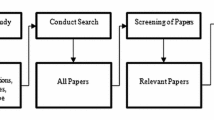Abstract
Variable neighborhood search (VNS) is a proven heuristic framework for finding good solutions to combinatorial and global optimization problems. In this paper two VNS-based heuristics are proposed for solving the capacitated clustering problem. The first follows a standard VNS approach, and the second a skewed VNS that allows moves to inferior solutions. The performance of the two heuristics is assessed on benchmark instances from the literature. We also compare their performance against a recently published iterated VNS procedure. All VNS procedures outperform the state-of-the-art, but the Skewed VNS is best overall. This would suggest that using acceptance criteria before allowing moves to inferior solutions in Skewed VNS is preferable to the random shaking approach that is used in Iterated VNS to move to new regions of the solution space.



Similar content being viewed by others
References
Brimberg, J., Hansen, P., & Mladenović, N. (2010). Attraction probabilities in variable neighborhood search. 4OR-QJ Operations Research, 8, 181–194.
Brimberg, J., Janićijević, S., Mladenović, N., & Urošević, D. (2015a). Solving the clique partitioning problem as a maximally diverse grouping problem. Optimization Letters, 1–13. doi:10.1007/s11590-015-0869-4.
Brimberg, J., Mladenović, N., & Urošević, D. (2015b). Solving the maximally diverse grouping problem by skewed general variable neighborhood search. Information Sciences, 295, 650–675.
Brimberg, J., Mladenović, N., Todosijević, R., & Urošević, D. (2016). Variable neighborhood descent for the capacitated clustering problem. Lecture Notes in Computer Science, 9869, 336–349.
Deng, Y., & Bard, J. F. (2011). A reactive grasp with path relinking for capacitated clustering. Journal of Heuristics, 17(2), 119–152.
Duarte, A., & Martí, R. (2007). Tabu search and grasp for the maximum diversity problem. European Journal of Operational Research, 178, 71–84.
Fan, Z. P., Chen, Y., Ma, J., & Zeng, S. (2010). A hybrid genetic algorithmic approach to the maximally diverse grouping problem. Journal of Operational Research Society, 62, 92–99.
Gallego, M., Laguna, M., Martí, R., & Duarte, A. (2012). Tabu search with strategic oscillation for the maximally diverse grouping problem. Journal of the Operational Research Society, 64(5), 724–734.
Lai, X., & Hao, J. K. (2016). Iterated variable neighborhood search for the capacitated clustering problem. Engineering Applications of Artificial Intelligence, 56, 102–120.
Martínez-Gavara, A., Campos, V., Gallego, M., Laguna, M., & Martí, R. (2015). Tabu search and grasp for the capacitated clustering problem. Computational Optimization and Applications, 62(2), 589–607.
Morán-Mirabal, L., González-Velarde, J., Resende, M. G., & Silva, R. M. (2013). Randomized heuristics for handover minimization in mobility networks. Journal of Heuristics, 19(6), 845–880.
Rodriguez, F., Lozano, M., García-Martínez, C., & González-Barrera, J. (2013). An artificial bee colony algorithm for the maximally diverse grouping problem. Inormation Sciences, 230, 183–196.
Urošević, D. (2014). Variable neighborhood search for maximum diverse grouping problem. Yugoslav Journal of Operations Research, 24(1), 21–33.
Acknowledgements
The research has been supported in part by Research Grants 174010 and III 044006 of the Serbian Ministry of Education, Science and Technological Development, and a Natural Sciences and Engineering Research Council of Canada Discovery Grant (NSERC #205041-2014).
Author information
Authors and Affiliations
Corresponding author
Appendix
Appendix
See Tables 8, 9, 10, 11, 12, 13, 14, 15, 16, 17.
Rights and permissions
About this article
Cite this article
Brimberg, J., Mladenović, N., Todosijević, R. et al. Solving the capacitated clustering problem with variable neighborhood search. Ann Oper Res 272, 289–321 (2019). https://doi.org/10.1007/s10479-017-2601-5
Published:
Issue Date:
DOI: https://doi.org/10.1007/s10479-017-2601-5




